WALKING & VIRTUAL TOURS
I have been leading guided walks in the Hampstead area for some 25 years and qualified as a City of London Guide in 2015 and a City of Westminster Guide in 2025.
Examples of clients for private or commissioned tours include: The Friends of the Royal Academy of Art, Hampstead Museum, University of the Third Age groups, Charles Russell Speechlys LLP.
The following walks can be booked as private tours, or you can book as an individual when you see them advertised via Eventbrite. Walks are regularly being developed and updated.
Walks vary from 1.5 hours to 2.5 hours and can be tailored for different ages and requirements.
Some of my walks have also been made into one hour virtual tours.
"We loved the virtual tour of the alleys, lanes and history of Hampstead. Marilyn Greene is a super guide. She really knows her subject and brings the history to life with a talk peppered with fascinating facts and anecdotes" Trip advisor 5 * review May 2021

CITY OF LONDON WALKS
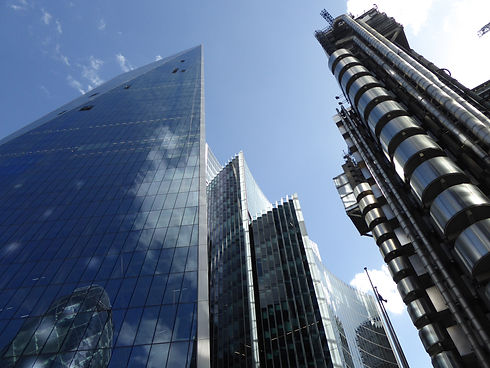
Reach for the Sky: business and trading in the City
The City of London was established in Roman times. The City of London, contained within the Roman walls that largely existed until the 17th century, developed its own commercial identity along its tight-knit medieval pattern of narrow streets and alleyways. Walking through its heart, we will discover the foundations for trade and business; admire the architecture of churches, livery halls and important financial institutions and learn how major events in the City’s history have affected trade. The City used to be highly populated with people living close to their business and places of worship. Now only about 8000 people live in the City of London whilst over 350,000 (and increasing) people commute into the City each working day, contributing to a dramatic and quieter change of atmosphere and identity at the weekends. We will learn about the 1990s IRA bombings and attempts to destroy buildings relating to its financial infrastructure. We will see how business developments and skyscrapers, competing for space and reaching for the sky are changing the City’s sky-line.
This walk is available as a virtual tour
Sky scrapers in the Bishopsgate area, City of London
Rescued, Revealed Restored: The Blitz and Preserving History
Imagine 300 bombs raining down every minute on the City of London on the night of 29th December, 1940. Anyone waking up in the City on 30th December, 1940 would have seen a completely different City that would never be the same again. This walk takes you through one of the most severely bombed areas of the City, mainly north of St Paul's Cathedral. By the end of the Second World War a quarter of the City’s dwellings had been destroyed and 565 people killed or severely injured. We will hear stories of trying to rescue buildings during the Blitz; take a look at some of the historic buildings that were damaged but now remain as monuments or have been restored or rebuilt after the War and we will see how later excavations revealed key archaeological findings. We can also see how the Blitz led to the re-planning of a far more spacious city.
This walk is available as a virtual tour
St Paul's with National Firefighters Memorial City of London
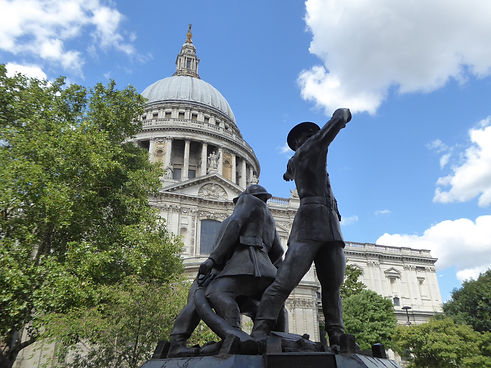


Between two Bars – Strolling along
Fleet Street
Walking from the site of the original Temple Bar in Fleet Street, we will discuss its original function and its removal. Continuing up Fleet Street and Ludgate Hill, we will learn about its strategic geographic position and how it became part of the City of London and admire some of the monuments, buildings and churches which make this route so historic. We will conclude at the newly positioned Temple Bar in Paternoster Square.
This walk is available in two versions of virtual tour, 1 hour and extended, more detailed 1.5 hours
Picture: View up Fleet Street from the entrance to the City from Westminster where Temple Bar was positioned.
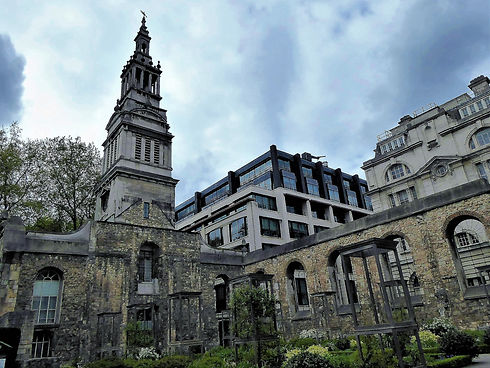
Gardens of The Blitz
Discover the delightful, gardens of the City, created from bomb sites of the Second World War. This walk spans the length of the City, revealing the history of past industrial buildings where stood former Sir Christopher Wren churches, livery halls, Roman ruins and the site of a Roman bath house. It ends at the beautiful ruins of St Dunstan in the east, a short distance from Tower Hill and Monument stations.
This walk is available as a virtual tour
Ruins of Christ Church Greyfriars, City of London.JPG
Keeping up with the Tides: the Thames and its Changing History
The Thames is the longest river in England and is controlled by its tides. The Romans first built a wooden bridge across it, near today’s London Bridge. The river, the one constant recognisable feature of the City of London, has witnessed its turbulent changing history. We will walk from the Pool of London to Blackfriars and see the features, buildings, names and artwork which reflect the history of the City and Southwark and reflect on future developments that lie on the horizon.
Picture: View towards the Millenieum and Blackfriars railway and road bridges
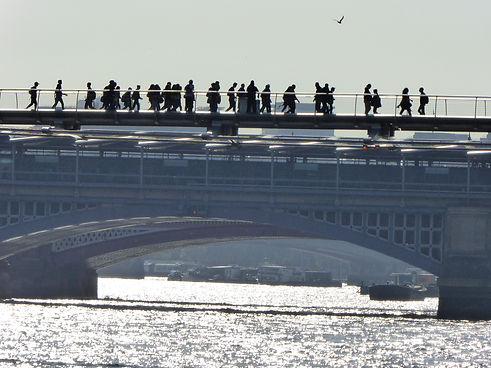
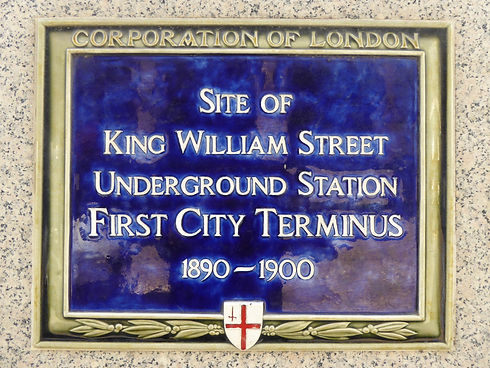
Trains, Drains and Remains
Our journey starts at Blackfriars, considering the history of the City that is largely under our feet. We discuss the development of the Tube in the City and how it relates to embanking the Thames; peer over Blackfriars Bridge to see if we can spot where the River Fleet feeds into the Thames and discuss modern day sewers. We then weave through the narrow streets to the site of the old Blackfriars Monastery and through the heart of the City. We view archaeological remains; where human remains were once buried; see where water conduits were installed and walk along a former river that, in later times, became a drain before clogging up completely. We will finish our Journey by London Bridge, at the site of the first deep level tube station.
This walk is available as a virtual tour
Picture: City of London Plaque to the King William Street Terminus near Monument
Women, work and worth
How much influence have women had in the City of London’s history? This walk explores the roles that women have taken on and how they have shown their strength in a male dominated society from medieval times to the present day. We also discuss early twentieth-century suffragists and suffragettes and their impact they had to changing society.
Picture: Women workers for the fire service in the Second World War depicted on the National Firefighters' memorial
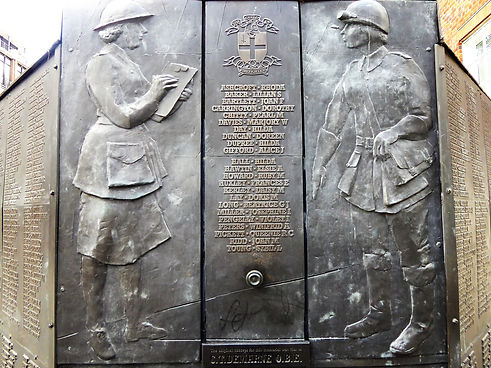
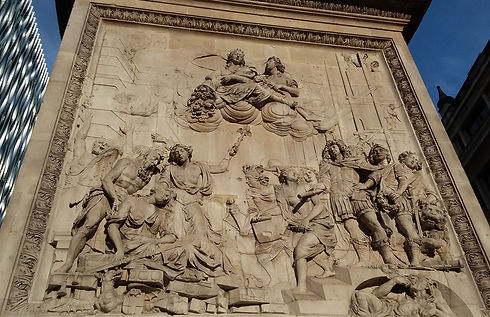
The Great Fire of London
Tracing the path of the Great Fire of London that burned from 2nd September 1666 for 4 days, we unravel the drama and stories associated with the fire and its aftermath. It devastated 5/6 of the City including:13,200 houses, 87 churches, St Paul’s Cathedral, The Royal Exchange, The Custom House, 52 livery company halls, 3 City gates, Guildhall and Newgate Gaol. The walk uses quotes from eye witness accounts, particularly by the diarists Samuel Pepys and John Evelyn. The walk commences at the Monument, near to where the Great Fire started and ends at Smithfield, just beyond one of the places that the fire stopped.
Picture: Monument frieze showing the allegorical personification of the City recovering from the ruined City and being greeting by King Charles II

ABOUT US
Sanctuary in the City: Public Art by Refugees and Immigrants
Since Roman times the City of London has always been home to immigrant communities and were crucial such industries as banking and the early coffee houses. This walks winds its way through the City looks at immigrants who made a mark there mark here in a literal way as it is home to some of their sculptures and reliefs. The first official public sculpture, the monument was carved by Caius Gabriel Cibber a Danish immigrant, a drinking fountain by French refugee, Aimé-Jules Dalou, mosaics by Russian born Boris Anrep and perhaps the most significant contribution of sculptures are by a number of refugees from Nazi Europe and settled in the UK such as Naomi Blake, Frank Meisler, Oscar Nemon and Georg Ehrlrich . The most recent sculpture is Unity, 1992 by a Croatian refugee from former Yugoslavia, Ivan Klapez.
This walk is available as a virtual tour
Picture: Kindertransport, 2006 by Frank Meisler (1925-2018)

HAMPSTEAD WALKS
Alleys and Lanes of Hampstead
Experience the attractive and intricate network of alleys and lanes hidden behind the main roads of old Hampstead and discover how the village developed from a fashionable spa in the 18th century to a thriving village with thriving amenities in the 19th century.
This walk is available as a virtual tour
Picture: Holly Mount and view of the Holly Bush pub, Hampstead

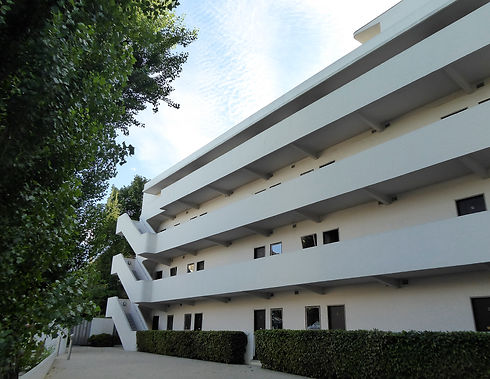
Modernist Hampstead
Discover the revolutionary Modernist homes and idealistic architecture built in Hampstead in the 1930s, such as The Sun House by Maxwell Fry and 66 Frognal by Connell Ward and Lucus that caused quite a controversy with the neighbours. Much of the architecture echoes design trends in Europe of the time with some architects also incorporating elements of eighteenth-century architectural design. This walk will finish at the iconic and idealistic Isokon flats in Belsize Park, passing some more recent examples of Modernism, as well as striking non-modernist Hampstead buildings.
This walk is also available as a virtual tour
Picture: Isokon Flats, in Modernist style by Wells Coates 1934, Belsize Park
Constable’s Hampstead
The artist John Constable at first rented houses in Hampstead and, in 1827, made it his permanent home.Discover the picturesque Georgian and Regency Hampstead that Constable would have been familiar with; where he lived; the houses and landscapes he painted as well as his family tomb. This talk is illustrated with pictures and frank quotes from letters to his friends about his art and feelings for Hampstead as well as some reflections by his biographer, C.R. Leslie.
This is available for officially recognised educational establishments in as a virtual tour or in an adapted format otherwise.
Picture: West Heath (site of Branch Hill Pond), Hampstead
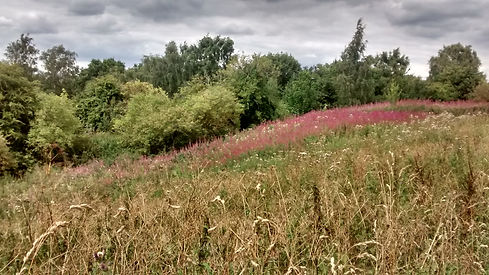
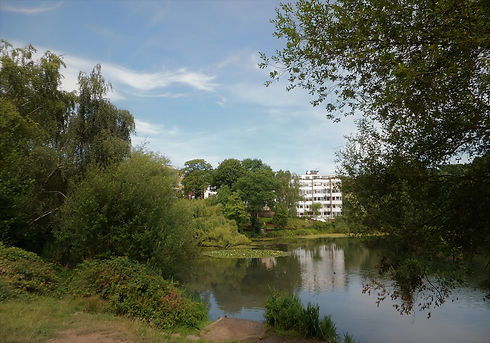
Hampstead and the Slade School of Art
In the early 20th century several important artists, who studied at the Slade School of Art, lived and/or socialised in Hampstead. We will take a detailed walk in the footsteps of the artists such as Mark Gertler, Stanley Spencer and R.W. Nevinson who socialised in Downshire Hill with the artistic Carline family. We will hear of their loves, hates and reactions to the First World War. A small diversion will take us to the Vale of Health where the former Vale of Health Hotel. Adjacent to this was situated the site of the Hampstead fairground, painted by both Stanley Spencer and Mark Gertler.
Picture: The Vale of Health Looking towards where the former Vale of Health hotel was
Pioneers of Modern Art
In the first half of the 20th century Hampstead was home to some of the era's most pioneering artists. We will walk in the footsteps of the Slade School artists such as Mark Gertler, Stanley Spencer and R.W. Nevinson who socialised in Downshire Hill with the artistic Carline family. We will hear of their loves, hates and reactions to the First World War. A small diversion will take us to the Vale of Health where the former Vale of Health Hotel was situated and we will and see the site of the old Hampstead fairground painted by both Stanley Spencer and Mark Gertler. In Downshire Hill we will also discuss the role that Roland Pevsner, Margaret Gardiner and Fred and Diana Uhlman played in the art world in the years leading up to, and during, the Second World War. We walk to Belsize Park to learn of the Modernists including Henry Moore, Pierre Mondrian and Barbara Hepworth whom Herbert Read described as living as a “nest of gentle artists” and conclude with the refugee designers who stayed at the Isokon flats before moving to pastures new.
Picture: Blue plaque to Roland Penrose surrealist, and Lee Miller photographer, Downshire Hill, Hampstead


In the Footsteps of Fred Uhlman – art and refugees in Hampstead
Fred Uhlman was a refugee lawyer turned artist who settled with his English wife, Diana, in Downshire Hill in 1938. We learn how together they formed the artist refugee committee to rescue artists trapped in Czechoslovakia and about how their house became a refuge for artists. We hear about the organisations that he was involved in; visit sites he was known to frequent; discuss the role of his artistic friends and neighbours and consider other refugees who settled in Hampstead in the advent to the Second World War.
Picture: The Coffee Cup, Hampstead High Street which Uhlman frequented
Hampstead in the First World War
'...across the Heath: and there, in the sky, like some god vision, a Zeppelin, and the searchlights catching it, so that it gleamed like a manifestation in the heavens...' D.H. Lawrence in his book, 'Kangaroo' (1923) probably describing the devastating Zeppelin raid over London on 8 September 1915, seen from Hampstead Heath.
Discover Hampstead during the First World War. See where soldiers and cadets trained for the war effort, where injured soldiers were cared for, what shops and services were available at the time and how artistic personalities recorded and reacted to the War
Picture: Mount Vernon flats former consumption hospital converted into an Auxilary Hospital during the First World War
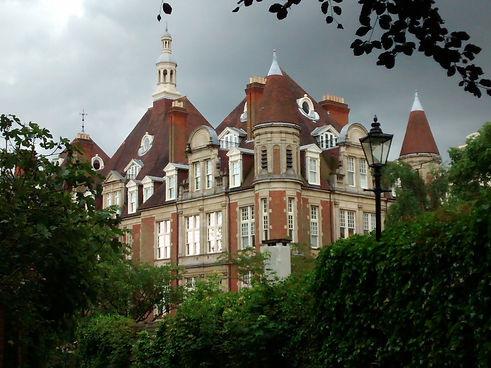

ABOUT US
Horrific Hampstead
Did you know that the last two women to be
hanged in Britain committed murders in Hampstead?
We may tend to think of Hampstead as a safe
genteel area where perhaps not that much drama
happens but is this the case? Over the centuries
Hampstead and Hampstead Heath have witnessed
many dramatic and horrifying events.
From highway men and hangings, to murders,
executions and fatal accidents, this walk explores
some of the stories of people involved in horrible
happenings in Hampstead from the 17th Century to
the 21st Century.
Picture: Plaque to Sir Henry Vane on wall to his former house.
He was beheaded for treason in the time of King Charles II

Lamp-Lit Hampstead
Discover the mysterious atmosphere to
Hampstead on a tour after-dark where the streets
are lit by old-fashioned lamps. We will wind
through the narrow back streets and catch glimpses
of its fascinating history from the glow of lamps and
lit buildings. This tour is particularly stunning over
the Festive season where subtle Christmas lights
add to the effect.
This walk is available as a virtual tour.
Picture: The lamp-lit memorial fountain to the gift of 6 acres
of land for the poor of Hampstead, Well Walk

The “Wyldes” of Hampstead: exploring Hampstead’s northern slopes
Discover the rural north side of Hampstead by walking across the Heath Extension to the hamlet of Northend, learning about its famous residents, its hostelry and the 17th-century Wyldes farmhouse. We return via the enchanting Hill Garden and Golders Hill Park. Circular walk starts and ends outside the main entrance to Golders Green.
Picture: Converted Barn from Wyldes Farmhouse from behind Hampstead Way
Hampstead to Golders Green Parkland walk
Starting in Hampstead and walking to the Heath brow at 442 feet/134.8 metres, we learn about the tube and the history and personalities of the area before descending down the hill through the Hill Garden with its pagoda and crossing from Camden to Barnet into Golders Hill Park with it variety of gardens, bird and animal houses. We will also discover who occupied these great houses and how their grounds were incorporated into Hampstead Heath. We finish with an introduction to Golders Green at the historic Hippodrome.
Picture: View towards Harrow from the Pergola in the Hill Garden

HAMPSTEAD GARDEN SUBURB WALKS
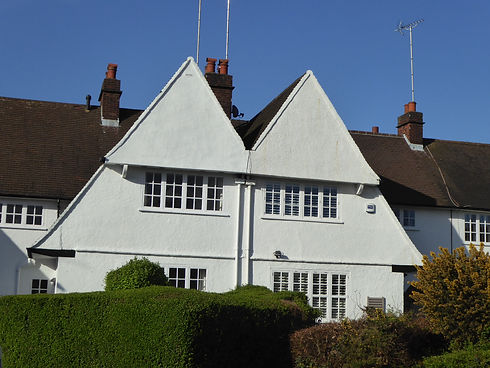
Henrietta’s Dream: Arts and Crafts in Hampstead Garden Suburb
Hampstead Garden Suburb was the idea of Henrietta Barnett, the wife of Cannon Barnett, the vicar of St Jude’s Whitechapel where they both became aware of extreme poverty, overcrowding and the affects of alcohol on the lives of the poor. In 1896 Henrietta Barnett heard of the plans to extend the Charing Cross and Euston Railways to the fields of Golders Green that lay beyond her Hampstead weekend home. To protect the land, and with the help of some worthy gentlemen, she purchased it to create the Hampstead Heath extension. Surrounding this she appointed the architects Barry Parker and Raymond Unwin to plan a Garden Suburb for all classes. This was to be a newly planned development with different types of housing, greens, tennis courts, allotments and preserved woodland – an antithesis to the life she had experienced in the East End.
The walk traces the early history and developments of Hampstead Garden Suburb and includes walking through part of the Hampstead Heath Extension, Central Square with its two Grade I Lutyens’ churches and the original quaint Artisans Quarter designed from 1907 by Parker and Unwin, aimed at bringing affordable rented housing, with fresh air and space, to the working classes.
This walk is available as a virtual tour
Picture: 'M' Gabled arts and crafts cottages by Courtney Crickmer, 1910, Hampstead Garden Suburb
From Stream-form to Arts and Crafts: inter-war architecture in Hampstead Garden Suburb
This walk goes back in time, looking at architectural styles from between the wars on the North side of Hampstead Garden Suburb, starting at the Modernist East Finchley station and finishing with arts and crafts cottages. As well as admiring the architecture we discuss some of the people that the street names commemorate, many of whom relate to the Christian Socialist movement and the early Garden City Movement.
This walk is available as a virtual tour
Picture: Belvedere Court flats, in streamform style by Ernst Freud, 1938, Hampstead Garden Suburb
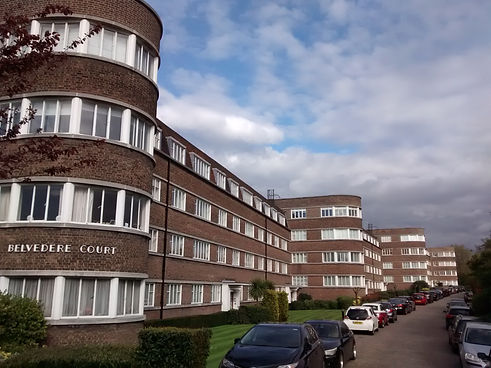
HIGHGATE WALKS
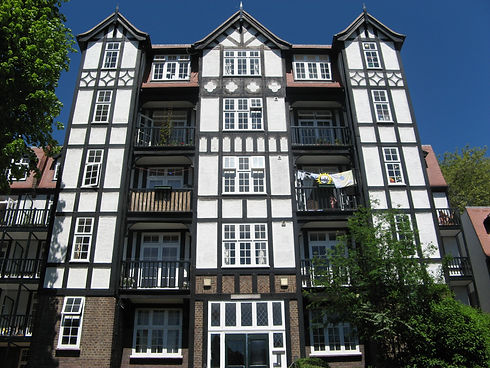
A Walk through Highgate: experiments in urban living
Discover some of Highgate's twentieth century housing developments in this historic walk through Highgate. We will pass Lubetkin's iconic High Point flats, learn about Highgate's early history, walk through Waterlow Park and learn of its conception, pass Highgate Cemetery where Karl Marx is buried, explore Abraham Davis's Holly Lodge Estate and Walter Segal's 1950s St Anne's Close.
We start opposite the Woodman Pub on Archway Road and finish at the bottom of Swain's Lane near Parliament Hill Fields.
This walk is available as a virtual tour.
Picture: Homes for Lady Workers in Tudabethan stye by Abraham Davis, 1920s, Holly Lodge Estate, Highgate

The Heights of Dickens
Follow in Charles Dickens’ footsteps in a walk from Highgate to the hamlet of Northend on the border with Hampstead and Hampstead Garden Suburb. We will follow some of Bill Sikes escape route after murdering Nancy in Oliver Twist, see houses that Dickens stayed in; learn about his friendship with philanthropist Baroness Angela Burdett-Coutts; view the house that inspired Steerforth’s mother's house in David Copperfield and peep into Highgate Cemetery where several members of the Dickens family were buried and follow the Gordon rioters in Barnaby Rudge towards Lord Mansfield’s country estate at Kenwood (Caen Wood). We will pay a visit o the Spaniard’s Inn featured in the Pickwick Papers and continue with Bill Sikes' journey in Oliver Twist from Highgate Hill across the grounds of Kenwood towards North End and Hendon. We finish in North End where we view the 17th farmhouse that Dickens lodged in after the death of his sister in law Mary Hogarth.
This walk is available as a virtual tour.
Picture: House in North Hill, Highgate that Dickens stayed in 1832

FINCHLEY WALKS
A Walk through Conservation Finchley
Discover three conservation areas preserved for
their special characteristics in Finchley N3.
Church End has been settled in since the 13th
century and we cans see the Church and trace
where some of the early buildings and facilities
were. We also look at the architectural detail and
building materials of the Victorian and Edwardian
houses and shops and take a detour to see
Stephens House, the home of "Inky" Stephens.
Continuing on, we come to the Finchley
Garden Village developed between 1908-1914
and we weave our way via the Dollis Valley
to College Farm, the last farm in Finchley which
in its hay-day served Londoners with fresh milk. A short
walk concludes our tour at the striking La Deliverance
statue, now listed as a First World War memorial
This walk is available as a virtual tour.
Picture: The King Edward Hall, 1911 by Turner and Higgins of Finchley
on the junction with Hendon Lane and Regents Park Road







